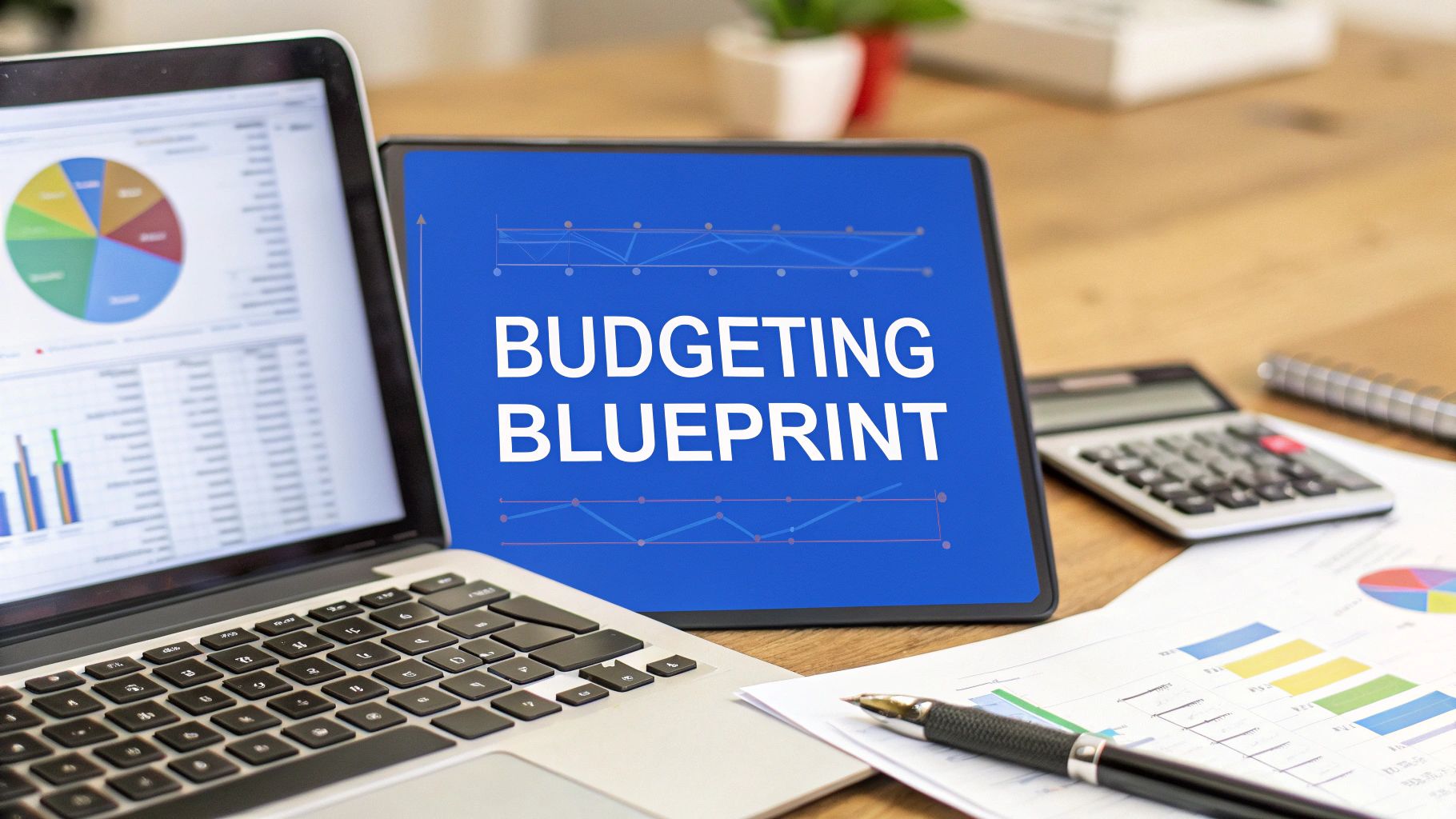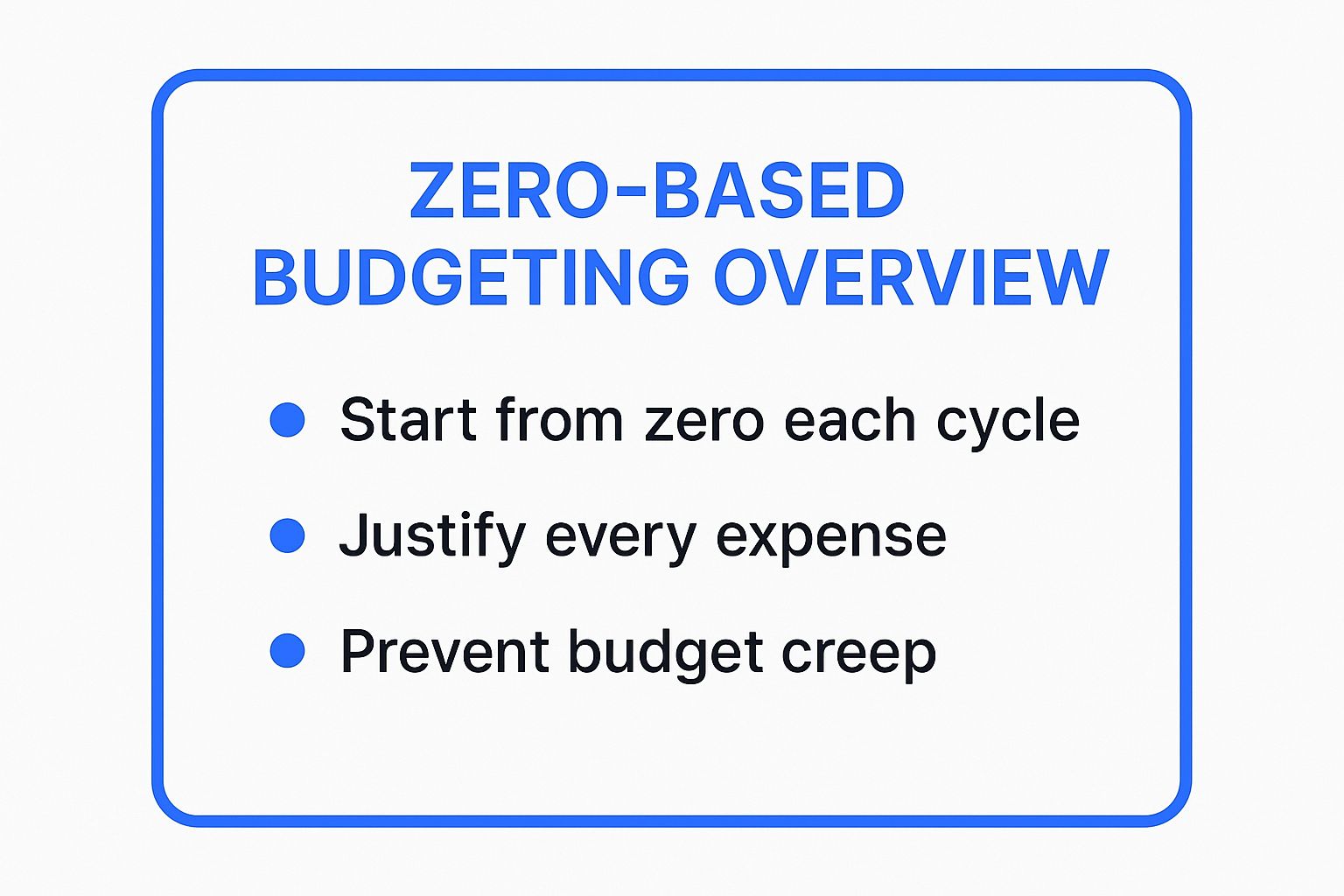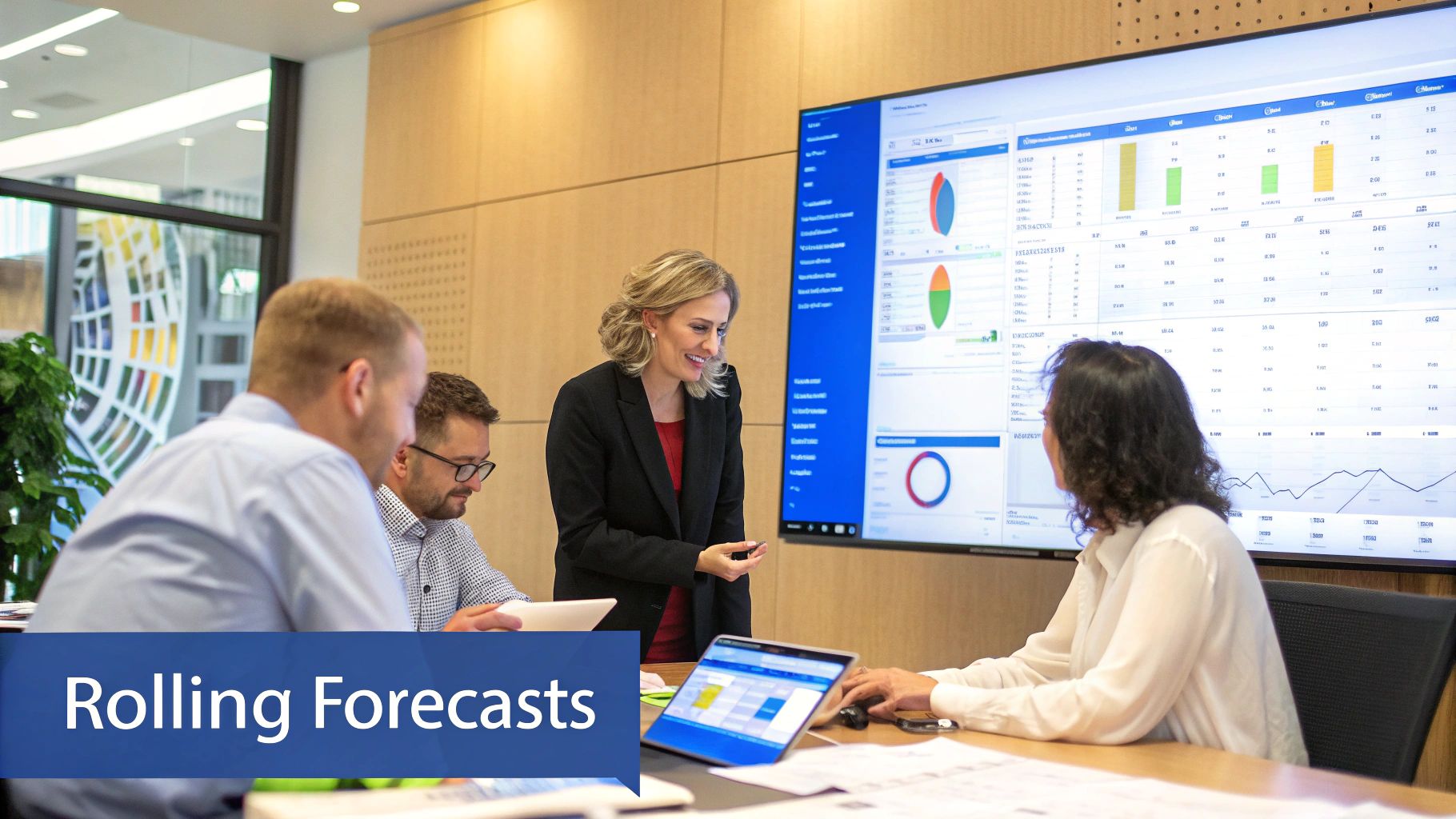Our Marketing Team at PopaDex
7 Budgeting Best Practices for 2025: A Deep Dive

In the world of personal and corporate finance, the term ‘budgeting’ often conjures images of restrictive spreadsheets and tedious line-item tracking. While essential, this traditional view barely scratches the surface of what is possible. The most effective financial strategies go beyond simple expense logging; they involve dynamic, forward-thinking frameworks that adapt to changing conditions and drive strategic goals. This article moves past generic advice to explore seven advanced budgeting best practices.
We will dissect powerful methodologies, from the radical clarity of Zero-Based Budgeting to the agile nature of Rolling Forecasts, providing actionable steps to implement them. You will learn how to align every dollar with your strategic priorities, improve decision-making with real-time data, and build a resilient financial plan for the years ahead.
To truly master these practices, having a unified view of your finances is non-negotiable. Tools like PopaDex, which consolidate all your accounts into one dashboard, provide the comprehensive overview necessary to implement these sophisticated strategies effectively. This integration turns complex data into clear, actionable insights, empowering you to take control of your financial future. Let’s explore the frameworks that will elevate your financial strategy.
1. Zero-Based Budgeting (ZBB): Justify Every Dollar
Traditional budgeting often involves making small, incremental adjustments to the previous year’s numbers. Zero-Based Budgeting (ZBB) throws that playbook out the window. This is one of the most transformative budgeting best practices because it forces you to build your budget from scratch, or a “zero base,” for every new cycle.
Instead of asking, “How can we adjust last year’s spending?” ZBB asks, “Is this expense still necessary, and if so, how much do we truly need for it?” This fundamental shift requires that every single dollar, whether for a personal subscription or a corporate project, be rigorously justified. It’s an intensive method that challenges ingrained spending habits and legacy costs, ensuring every allocation directly supports your most current financial and strategic goals.
How ZBB Drives Efficiency
The core benefit of ZBB is its ability to uncover hidden inefficiencies. For instance, Kraft Heinz famously used this approach to slash $1.7 billion in operational costs by scrutinizing everything from corporate travel to factory supplies. On a personal level, an individual applying ZBB would allocate their entire monthly income to specific categories like savings, debt repayment, housing, and groceries, ensuring that every dollar has a designated purpose and nothing is left to mindless spending.
This quick reference box summarizes the core principles of the ZBB method.

These principles work together to create a powerful system of financial accountability and optimization.
Actionable Tips for Implementation
Successfully implementing ZBB requires a structured approach. To avoid getting overwhelmed, consider these practical steps:
- Start Small: If you’re in an organization, pilot ZBB in a single department first. For personal use, try it for one month before committing to it long-term. This minimizes disruption and builds confidence.
- Leverage Technology: The process can be data-heavy. Using robust financial planning software or a comprehensive tracker like PopaDex is crucial for aggregating data, streamlining justifications, and managing the budget in real-time.
- Focus on Value: Frame the conversation around the value each expense creates, not just its cost. This encourages strategic thinking and helps secure buy-in from stakeholders or even helps you prioritize your own spending.
2. Rolling Forecasts: Adapting in Real-Time
Unlike static annual budgets that quickly become obsolete, rolling forecasts offer a dynamic and forward-looking approach to financial planning. This method is one of the most agile budgeting best practices because it involves continuously updating your forecast by adding a new period (like a month or quarter) as the most recent one concludes. This creates a perpetual, typically 12- to 18-month view of your financial future.

The primary goal isn’t to hit a fixed annual number set months ago, but to make informed, proactive decisions based on the most current data and market conditions. For businesses, especially in volatile industries like tech, this means constantly re-evaluating revenue projections and operational costs. For individuals, a rolling forecast helps adjust savings goals or spending plans in response to life events like a job change or unexpected expenses, keeping financial plans relevant and realistic.
How Rolling Forecasts Drive Agility
The core strength of a rolling forecast is its ability to foster organizational agility and strategic responsiveness. For example, Unilever famously abandoned its traditional annual budget in favor of a rolling forecast model to improve flexibility and adapt more quickly to consumer market shifts. Similarly, many fast-growing SaaS companies rely on this method to manage fluctuating subscription revenues and customer acquisition costs effectively.
This approach encourages a culture of continuous planning and analysis, moving away from the “set it and forget it” mentality of annual budgeting. By regularly looking ahead, organizations and individuals can anticipate challenges and seize opportunities far more effectively.
Actionable Tips for Implementation
Transitioning to a rolling forecast requires a shift in mindset and process. Use these steps to guide your implementation:
- Start with Key Metrics: Don’t try to forecast everything at once. Begin by focusing on a few critical financial drivers, such as sales, revenue, or major expenses, and expand the model over time as you become more comfortable.
- Automate Data Collection: Manually gathering data for each new forecast period is inefficient. Use a robust financial tool like PopaDex to automate data aggregation and reporting, freeing up time to focus on analysis and strategic planning.
- Train for Scenario Planning: A rolling forecast is most powerful when combined with what-if analysis. Train your team or yourself on scenario planning techniques to understand the potential impact of different outcomes. Explore our guide to learn more about scenario forecasting and financial planning.
3. Activity-Based Budgeting (ABB): Align Spending with Operations
While Zero-Based Budgeting forces a justification for every dollar, Activity-Based Budgeting (ABB) takes a different route by linking costs directly to the specific business activities that drive them. This method shifts the focus from “what are we buying?” to “what are we doing, and what does it cost?” It’s one of the most insightful budgeting best practices for businesses because it provides a clear, granular view of how operational activities consume resources.
Pioneered by figures like Robert Kaplan and Robin Cooper, ABB requires an organization to identify all the activities necessary to produce goods or services, such as machine setups, customer service calls, or quality inspections. A cost is then assigned to each activity. The final budget is built by forecasting the demand for these activities, offering a highly accurate and operationally relevant financial plan that connects spending directly to output.

How ABB Drives Efficiency
The primary strength of ABB is its ability to reveal the true cost drivers within an organization, enabling more strategic decisions. For instance, major manufacturers like Boeing and Caterpillar have used ABB to gain deep insights into their complex production processes. By understanding the cost of each activity, they could identify inefficiencies and optimize workflows, leading to significant cost reductions and better resource allocation. Similarly, hospitals use ABB to determine the actual cost of patient care by linking expenses to specific procedures and services provided.
This approach provides a transparent link between financial resources and operational performance, empowering managers to make smarter choices about which activities to streamline, expand, or eliminate.
Actionable Tips for Implementation
Implementing Activity-Based Budgeting requires a detailed and collaborative effort. Follow these steps for a smoother adoption:
- Start with High-Impact Areas: Don’t try to analyze every activity at once. Begin by focusing on high-cost or high-volume activities where improvements will yield the greatest financial benefit.
- Use Cross-Functional Teams: Involve employees from different departments (e.g., finance, operations, sales) to identify and define activities. This ensures a comprehensive and accurate understanding of how the business truly operates.
- Leverage Technology for Tracking: Manually tracking activities and their costs is nearly impossible at scale. Using a sophisticated financial planning tool like PopaDex can help manage the data, identify cost drivers, and link operational metrics to financial budgets seamlessly.
- Focus on Manageable Cost Drivers: Select a few key drivers for each activity (like the number of production runs or customer orders) to keep the model practical and easy to maintain.
4. Driver-Based Budgeting: Tying Finances to Operations
While many budgeting methods focus on financial line items, Driver-Based Budgeting (DBB) links financial forecasts directly to key operational activities. This is one of the most insightful budgeting best practices because it focuses on the “why” behind the numbers. Instead of just budgeting for a certain amount in sales commissions, it uses the underlying drivers, like the number of sales reps or the average deal size, to build the forecast.
The core principle of DBB is to identify the specific business activities or metrics that directly influence revenues and costs. For example, a SaaS company wouldn’t just project revenue; it would budget based on drivers like customer acquisition cost (CAC), monthly recurring revenue (MRR), and customer churn rate. This approach creates a more dynamic and realistic financial model that automatically adjusts as its operational drivers change, providing a clearer view of cause and effect.
How DBB Enhances Accuracy
The main advantage of DBB is its ability to create highly accurate and agile forecasts. Retailers, for instance, can use drivers like same-store sales growth and foot traffic to predict revenue far more reliably than just increasing last year’s number by a fixed percentage. Similarly, airlines use passenger load factors and available seat miles as primary drivers to model their financial performance.
This operational linkage makes the budget a strategic tool rather than just a financial exercise. It helps teams understand exactly how their daily activities contribute to the company’s bottom line.
Actionable Tips for Implementation
Implementing Driver-Based Budgeting effectively means choosing the right levers and validating their impact. Follow these steps for a successful rollout:
- Identify Key Drivers: Start by identifying the most influential operational metrics. Analyze historical data to confirm a strong correlation between a driver (e.g., website traffic) and a financial outcome (e.g., online sales).
- Validate the Model: Before fully committing, back-test your driver-based model against past results. Does a model based on last year’s drivers accurately predict last year’s financial outcomes? This helps confirm you’ve chosen the right metrics.
- Empower Operational Teams: Ensure that departmental leaders understand which drivers they control and how their performance impacts the overall budget. This fosters accountability and strategic alignment.
- Utilize a Centralized Platform: A DBB model can become complex. Using a financial planning tool like PopaDex is essential for tracking drivers, managing formulas, and running different scenarios to see how changes in operations might affect financial results.
5. Participatory Budgeting: Empower Your Team
Top-down budgeting, where senior leadership dictates financial limits, can often feel disconnected from the realities of day-to-day operations. Participatory budgeting flips this model by fostering a collaborative approach where department managers, team leaders, and even front-line employees contribute to building the budget. This is one of the most empowering budgeting best practices because it decentralizes financial planning and leverages the specialized knowledge of those closest to the work.
Instead of a single authority making all financial decisions, this method treats budgeting as a dialogue. It asks, “What resources do you need to achieve your objectives, and how can we align that with our overall strategy?” This approach enhances accuracy, as estimates are grounded in operational reality. It also significantly boosts morale and accountability, as participants feel a greater sense of ownership over the financial plan they helped create.
How Participatory Budgeting Drives Engagement
The primary advantage of this method is its ability to create a more engaged and financially literate workforce. For example, Toyota incorporates extensive employee participation in its planning processes, a key element of its renowned production system. This ensures that budgets are both realistic and optimized for efficiency on the factory floor. Similarly, many universities use this approach to allow academic departments to plan their own budgets, leading to more strategic use of funds for research and teaching.
The process fosters a culture where financial health is a shared responsibility, not just an executive-level concern.
Actionable Tips for Implementation
Rolling out a participatory budget requires careful management to ensure it remains productive and aligned with company goals. Consider these practical steps:
- Establish Clear Guidelines: Define the strategic priorities, overall financial constraints, and non-negotiable items upfront. This provides a clear framework for participants to work within, preventing unrealistic requests.
- Provide Budget Training: Not everyone is a financial expert. Offer workshops or resources to teach participants how to read financial statements, create forecasts, and understand key metrics. When you learn how to organize finances, the entire process becomes more effective.
- Use Structured Templates: Standardize the submission process with consistent templates and tools. A platform like PopaDex can help centralize submissions, track changes, and ensure all necessary data is captured uniformly, simplifying the final consolidation.
- Balance Participation with Efficiency: To avoid endless debate, set clear deadlines and decision-making protocols. Appoint a budget committee to review submissions and facilitate final negotiations, ensuring the process moves forward.
6. Flexible Budgeting: Adapting to Reality
While many budgeting methods rely on static, fixed forecasts, flexible budgeting embraces change. This is one of the most practical budgeting best practices because it designs a budget that adjusts allowed expenses according to actual revenue or activity levels. Instead of being a rigid, one-size-fits-all plan, it provides a dynamic financial roadmap that reflects real-world performance.
A static budget might penalize a sales department for high travel costs during a record-breaking quarter. In contrast, a flexible budget asks, “Given our actual sales volume, what should our expenses have been?” This approach allows for a more accurate assessment of performance, differentiating between genuine inefficiencies and costs that logically rise with increased business activity. It’s a method that provides context, turning a budget from a rigid measuring stick into an intelligent management tool.
How Flexible Budgeting Drives Smarter Decisions
The primary benefit of flexible budgeting is its ability to provide a more meaningful variance analysis. For example, a manufacturing company with seasonal demand can use it to adjust production cost allowances based on actual units produced, preventing managers from being unfairly punished for high costs during peak season. Similarly, a retail business can create multiple budget scenarios for the holiday season, adjusting marketing and staffing budgets based on actual foot traffic and sales data.
This approach empowers managers to make better decisions by providing a realistic performance benchmark. It acknowledges that not all costs are within immediate control and that many are directly tied to the level of business activity.
Actionable Tips for Implementation
Successfully implementing a flexible budget requires careful analysis and clear communication. Here are a few tips to get started:
- Identify Fixed vs. Variable Costs: The first step is to meticulously separate costs that remain constant (like rent) from those that change with activity levels (like raw materials or sales commissions). This is the foundation of your flexible model.
- Establish Cost Formulas: Use historical data or statistical analysis to create a formula for each variable cost (e.g., Cost of Goods Sold = $5 per unit sold). This allows the budget to scale automatically.
- Leverage Financial Tools: Manually adjusting spreadsheets can be tedious. A platform like PopaDex helps track variable income and expenses, making it easier to see how your spending should adapt. You can learn more about mastering your budget on popadex.com to build these skills.
- Train Your Team: Ensure managers understand how the flexible budget works. They need to interpret variances correctly, recognizing that the goal is to evaluate efficiency at the actual level of activity, not just adherence to a static number.
7. Beyond Budgeting: Embracing Agility and Decentralization
The Beyond Budgeting model challenges the very foundation of traditional budgeting, advocating for its complete abandonment. Instead of fixed annual budgets, this philosophy, popularized by Jeremy Hope and Robin Fraser, promotes a more adaptive and decentralized approach to performance management. This is one of the most radical budgeting best practices because it replaces rigid, top-down control with a framework of trust, empowerment, and continuous planning.
At its core, Beyond Budgeting argues that traditional budgets are too slow, stifle innovation, and encourage unethical behavior like sandbagging or unnecessary spending to meet targets. It replaces these outdated systems with rolling forecasts, relative performance targets, and a culture where front-line teams are empowered to make decisions. This creates a highly responsive organization that can adapt quickly to market changes without being constrained by an annual plan set months in advance.
How Beyond Budgeting Drives Performance
The real power of this model lies in its ability to align performance with strategic goals in a dynamic environment. For example, Swedish bank Handelsbanken has operated without budgets for over 40 years, consistently outperforming its peers by empowering branch managers. Similarly, Norwegian energy giant Equinor (formerly Statoil) implemented Beyond Budgeting principles to foster a more agile and performance-driven culture, moving away from detailed, command-and-control financial plans.
By focusing on relative benchmarks and empowering employees, companies can foster a sense of ownership and accountability that drives genuine value creation rather than just hitting arbitrary numbers.
Actionable Tips for Implementation
Transitioning to a Beyond Budgeting model is a significant cultural shift that requires careful planning. Here are a few steps to guide the process:
- Lead with Mindset: This is a cultural transformation before it’s a financial one. Leadership must fully commit to empowering teams and moving away from a command-and-control management style.
- Develop Relative Measures: Replace fixed targets with relative performance indicators that benchmark against competitors, market indices, or internal peers. This keeps goals relevant and ambitious.
- Invest in Real-Time Information: Empowered teams need access to real-time data to make informed decisions. Tools like PopaDex can be configured to provide dynamic dashboards and rolling forecasts, offering the timely insights necessary to operate effectively without a static budget.
- Establish Clear Governance: While you’re removing the traditional budget, you still need clear principles and boundaries. Create a strong governance framework that defines decision rights and strategic priorities.
7 Budgeting Best Practices Comparison
| Budgeting Method | Implementation Complexity 🔄 | Resource Requirements ⚡ | Expected Outcomes 📊 | Ideal Use Cases 💡 | Key Advantages ⭐ |
|---|---|---|---|---|---|
| Zero-Based Budgeting (ZBB) | High - very time-intensive and resource-heavy | High - requires training and cultural change | Detailed cost understanding, eliminates waste | Complex organizations needing cost control | Eliminates waste, prevents budget creep, aligns spending with priorities |
| Rolling Forecasts | Medium - requires regular updates and robust systems | Medium - needs forecasting tools and training | Dynamic, accurate, forward-looking budgets | Companies in volatile or rapidly changing markets | Improves agility, reduces surprises, better cash flow management |
| Activity-Based Budgeting (ABB) | High - complex activity mapping and data collection | High - needs detailed costing and accounting systems | Accurate cost allocation, operational efficiency | Manufacturing, healthcare, organizations needing detailed cost insight | Identifies value-adding activities, improves resource allocation |
| Driver-Based Budgeting | Medium - requires identification and validation of drivers | Medium - requires historical data and modeling | Responsive, scenario-capable budgets | Businesses with predictable key drivers (e.g., retail, SaaS) | Faster updates, better scenario planning, clear cost drivers linkage |
| Participatory Budgeting | Medium-High - coordinating multiple levels and collaboration | Medium - requires facilitation and training | Increased buy-in, improved accuracy | Organizations emphasizing empowerment and local expertise | Enhances communication, leverages local knowledge, increases commitment |
| Flexible Budgeting | Medium - needs understanding of cost behavior and variance analysis | Medium - statistical and accounting resources | Budgets adjusted for actual activity levels | Seasonal/variable demand industries | Better cost control, meaningful performance comparison, adaptable to changes |
| Beyond Budgeting | High - requires cultural shift and new performance systems | Medium-High - real-time reporting and governance | Increased agility, reduced budget process time | Agile organizations in dynamic industries | Encourages innovation, reduces gaming, decentralized decision-making |
From Practice to Performance: Implementing Your New Budgeting Framework
We’ve explored a powerful suite of advanced budgeting frameworks, moving far beyond simple expense tracking. From the meticulous detail of Zero-Based Budgeting to the agile foresight of Rolling Forecasts and the liberating principles of Beyond Budgeting, you now have a toolkit for transforming your financial management. The journey from reading about these concepts to mastering them begins with understanding a fundamental truth: a budget is not a restriction; it’s a strategic blueprint for achieving your goals.
The common thread weaving through all these budgeting best practices is the need for clarity and control. You cannot effectively implement Activity-Based Budgeting without understanding the true cost drivers of your spending, nor can you create a meaningful Flexible Budget without a clear view of your variable income and expenses. This is where theory meets reality. Successful implementation hinges on your ability to see the complete picture of your financial life in real-time.
Your Action Plan for Financial Transformation
To turn these insights into tangible results, you need a clear path forward. Don’t try to implement everything at once. Instead, focus on a deliberate, step-by-step approach.
- Step 1: Choose Your Starting Framework. Review the seven practices we’ve covered. Which one resonates most with your current financial situation and future goals? If you have irregular income, a Flexible Budget might be the perfect start. If you feel your spending has become bloated and inefficient, Zero-Based Budgeting offers a powerful reset.
- Step 2: Consolidate Your Financial Data. The single biggest obstacle to effective budgeting is fragmented information. You cannot build a robust framework when your data is scattered across banking apps, brokerage portals, and credit card statements. Your immediate priority is to establish a single source of truth.
- Step 3: Commit to a Regular Review Cadence. A budget is a living document, not a “set it and forget it” exercise. Whether it’s a weekly check-in or a monthly deep dive, schedule dedicated time to review your performance against your plan. This consistent engagement is what separates financial aspiration from financial achievement.
The Long-Term Impact of Strategic Budgeting
Mastering these sophisticated budgeting best practices does more than just organize your finances; it fundamentally changes your relationship with money. It shifts your perspective from being a passive observer of your financial situation to an active architect of your wealth. By adopting a strategic framework, you empower yourself to make proactive, data-driven decisions that align with your most important life objectives, whether that’s planning for an early retirement, funding a business venture, or building a lasting legacy. This proactive stance is the ultimate key to unlocking long-term financial security and freedom.
Ready to move from theory to action? A world-class budgeting strategy requires a world-class tool to provide the necessary clarity. PopaDex consolidates all your accounts into one powerful dashboard, giving you the holistic, real-time data needed to implement these advanced budgeting best practices with confidence. Sign up for free and build your financial command center today at PopaDex.